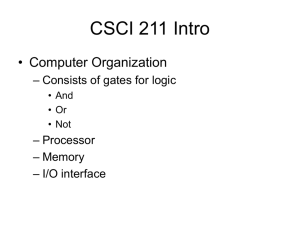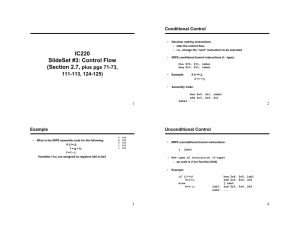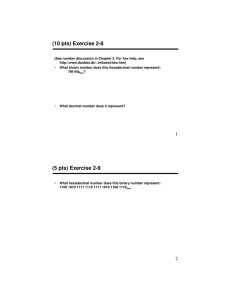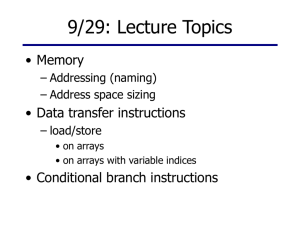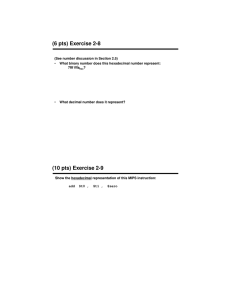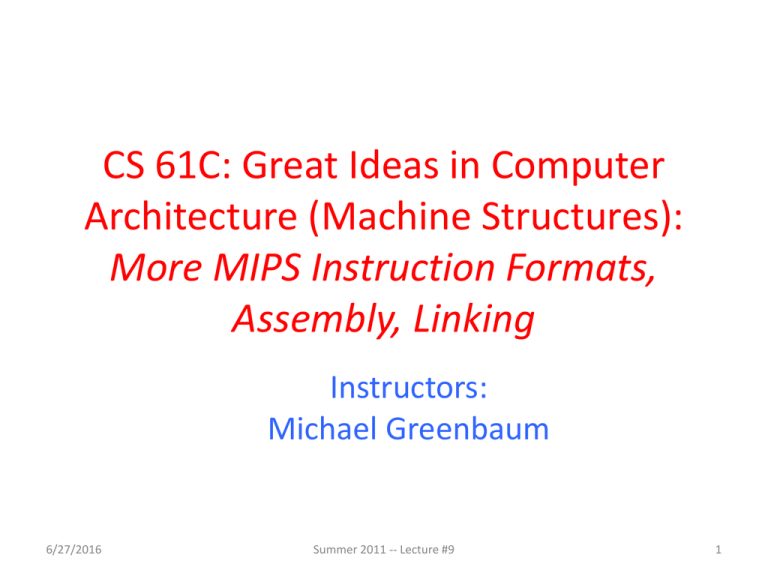
CS 61C: Great Ideas in Computer
Architecture (Machine Structures):
More MIPS Instruction Formats,
Assembly, Linking
Instructors:
Michael Greenbaum
6/27/2016
Summer 2011 -- Lecture #9
1
Agenda
•
•
•
•
•
•
I and J Instruction Formats
Administrivia
The Assembler
Break
Linking
Conclusion
6/27/2016
Summer 2011 -- Lecture #9
2
Levels of
Representation/Interpretation
High Level Language
Program (e.g., C)
Compiler
Assembly Language
Program (e.g., MIPS)
Assembler
Machine Language
Program (MIPS)
temp = v[k];
v[k] = v[k+1];
v[k+1] = temp;
lw
lw
sw
sw
0000
1010
1100
0101
$t0, 0($2)
$t1, 4($2)
$t1, 0($2)
$t0, 4($2)
1001
1111
0110
1000
1100
0101
1010
0000
We are here!
Anything can be represented
as a number,
i.e., data or instructions
0110
1000
1111
1001
1010
0000
0101
1100
1111
1001
1000
0110
0101
1100
0000
1010
1000
0110
1001
1111
Machine
Interpretation
Hardware Architecture Description
(e.g., block diagrams)
Architecture
Implementation
Logic Circuit Description
(Circuit Schematic Diagrams)Spring 2011 -- Lecture #7
6/27/2016
3
Review
• MIPS Machine Language Instruction:
Encode an instruction in 32 bits!
R opcode
I opcode
rs
rs
rt
rt
rd
shamt funct
immediate
• Reading an instruction starts by decoding the
opcode field.
• J-Format – Coming up soon…
Data Transfer Instructions
• The data transfer instructions (lw,sw,lb,sb,etc.) specify two
registers and a constant (the offset).
• Represented with I-Format
• Example:
lw $t0 -4($t1)
opcode = 35 => 100011
rs = 9 ($t1) => 01001
rt = 8 ($t0) => 01000
imm = -4 => 1111111111111100
100011 01001 01000 1111111111111100
6/27/2016
Summer 2011 -- Lecture #9
5
16-Bit Immediate?
• Unsigned # sign-extended?
– addiu, sltiu, sign-extends immediates to 32
bits. Thus, # is a “signed” integer.
• Rationale
– addiu so that can add w/out overflow. Remember, the u
means don’t signal overflow, not signed vs unsigned
integers!
– sltiu suffers so that we can have easy HW
• Does this mean we’ll get wrong answers?
• Nope, it means assembler has to handle any unsigned
immediate 215 ≤ n < 216 (I.e., with a 1 in the 15th bit
and 0s in the upper 2 bytes) as it does for numbers that
are too large.
16-Bit Immediate?
• Problem:
– Chances are that addi, lw, sw and slti will
use immediates small enough to fit in the
immediate field.
– …but what if it’s too big? What about logic
operations?
– Want to support up to a 32-bit immediate
• Allows full bitwise logic operations
• Not much point in supporting larger than processer
word size
16-Bit Immediate?
• Solution to Problem:
– Handle it in software + new instruction
– Don’t change the current instructions: instead,
add a new instruction to help out
• New instruction:
lui
register, immediate
– stands for Load Upper Immediate
– takes 16-bit immediate and puts these bits in the
upper half (high order half) of the register
– sets lower half to 0s
16-Bit Immediate?
• Solution to Problem (continued):
– So how does lui help us?
– Example:
addi $t0,$t0, 0xABABCDCD
…becomes
lui $at, 0xABAB
ori $at, $at, 0xCDCD
add $t0,$t0,$at
– Now each I-format instruction has only a 16-bit
immediate.
– Wouldn’t it be nice if the assembler would this for us
automatically? (later)
Branches: PC-Relative Addressing (1/5)
• Use I-Format
opcode
rs
rt
immediate
• opcode specifies beq versus bne
• rs and rt specify registers to compare
• What can immediate specify?
– immediate is only 16 bits
– PC (Program Counter) has byte address of current
instruction being executed;
32-bit pointer to memory
– So immediate cannot specify entire address to branch
to.
Branches: PC-Relative Addressing (2/5)
• How do we typically use branches?
– Answer: if-else, while, for
– Loops are generally small: usually up to 50
instructions
– Function calls and unconditional jumps are done
using jump instructions (j and jal), not the
branches.
• Conclusion: may want to branch to anywhere
in memory, but a branch often changes PC by
a small amount
Branches: PC-Relative Addressing (3/5)
• Solution to branches in a 32-bit instruction: PCRelative Addressing
• Let the 16-bit immediate field be a signed
two’s complement integer to be added to the
PC if we take the branch.
• Now we can branch ± 215 bytes from the PC,
which should be enough to cover almost any
loop.
• Any ideas to further optimize this?
Branches: PC-Relative Addressing (4/5)
• Note: Instructions are words, so they’re word
aligned (byte address is always a multiple of 4,
which means it ends with 00 in binary).
– So the number of bytes to add to the PC will always
be a multiple of 4.
– So specify the immediate in words.
• Now, we can branch ± 215 words from the PC
(or ± 217 bytes), so we can handle loops 4 times
as large.
Branches: PC-Relative Addressing (5/5)
• Branch Calculation:
– If we don’t take the branch:
PC = PC + 4 = byte address of next instruction
– If we do take the branch:
PC = (PC + 4) + (immediate * 4)
– Observations
• Immediate field specifies the number of words to
jump, which is simply the number of instructions to
jump.
• Immediate field can be positive or negative.
• Due to hardware, add immediate to (PC+4), not to PC;
will be clearer why later in course
Branch Example (1/3)
• MIPS Code:
Loop: beq
addu
addiu
j
End:
$9,$0,End
$8,$8,$10
$9,$9,-1
Loop
• beq branch is I-Format:
opcode = 4 (look up in table)
rs = 9 (first operand)
rt = 0 (second operand)
immediate = ???
Branch Example (2/3)
• MIPS Code:
Loop: beq
addu
addiu
j
End:
$9,$0,End
$8,$8,$10
$9,$9,-1
Loop
• immediate Field:
– Number of instructions to add to (or subtract
from) the PC, starting at the instruction following
the branch.
– In beq case, immediate = 3
Branch Example (3/3)
• MIPS Code:
Loop: beq
addu
addiu
j
End:
$9,$0,End
$8,$8,$10
$9,$9,-1
Loop
decimal representation:
4
9
0
binary representation:
3
000100 01001 00000 0000000000000011
Questions on PC-Relative addressing
• Does the value in branch immediate field
change if we move the code?
• What do we do if destination is > 215
instructions away from branch?
J-Format Instructions (1/5)
• For branches, we assumed that we won’t want
to branch too far, so we can specify change in
PC.
• For general jumps (j and jal), we may jump
to anywhere in memory.
• Ideally, we could specify a 32-bit memory
address to jump to.
• Unfortunately, we can’t fit both a 6-bit opcode
and a 32-bit address into a single 32-bit word,
so we compromise.
J-Format Instructions (2/5)
• Define two “fields” of these bit widths:
31
6 bits
26 bits
• As usual, each field has a name:
opcode
target address
• Key Concepts
– Keep opcode field identical to R-format and I-format
for consistency.
– Collapse all other fields to make room for large target
address.
0
J-Format Instructions (3/5)
• For now, we can specify 26 bits of the 32-bit
address.
• Optimization:
– Note that, just like with branches, jumps will only
jump to word aligned addresses, so last two bits
are always 00 (in binary).
– So let’s just take this for granted and not even
specify them.
J-Format Instructions (4/5)
• Now specify 28 bits of a 32-bit address
• Where do we get the other 4 bits?
– By definition, take the 4 highest order bits from
the PC.
– Technically, this means that we cannot jump to
anywhere in memory, but it’s adequate
99.9999…% of the time, since programs aren’t
that long
• only if straddle a 256 MB boundary
– If we absolutely need to specify a 32-bit address,
we can always put it in a register and use the jr
instruction.
J-Format Instructions (5/5)
• Summary:
– New PC = { (PC+4)[31..28], target address, 00 }
• Understand where each part came from!
• Note: { , , } means concatenation
{ 4 bits , 26 bits , 2 bits } = 32 bit address
– { 1010, 11111111111111111111111111, 00 } =
10101111111111111111111111111100
– Note: Book uses ||
Peer Instruction Question
When combining two C files into one executable,
recall we can compile and assemble them
independently & then merge them together.
When merging two or more binaries:
1)
2)
Jump insts don’t require any changes.
Branch insts don’t require any changes.
12
y) FF
p) FT
g) TF
r) TT
b)dunno
Peer Instruction Question
When combining two C files into one executable,
recall we can compile and assemble them
independently & then merge them together.
When merging two or more binaries:
1)
2)
Jump insts don’t require any changes.
Branch insts don’t require any changes.
1) What about calling function in another file?
Also, absolute addresses of labels may
change as multiple files are merged together.
2) Branch addresses are relative
12
y) FF
p) FT
g) TF
r) TT
b)dunno
Agenda
•
•
•
•
•
•
I and J Instruction Formats
Administrivia
The Assembler
Break
Linking
Conclusion
6/27/2016
Summer 2011 -- Lecture #9
26
Administrivia
• Project 1 has been posted
– Due Sunday at midnight
– Part 2 posted today – A short but “interesting”
MIPS program to run on your simulator.
– How are things going?
• The Midterm is next Friday.
– Exact location and time still TBD.
– Review session held next Monday.
6/27/2016
Summer 2011 -- Lecture #9
27
Agenda
•
•
•
•
•
•
I and J Instruction Formats
Administrivia
The Assembler
Break
Linking
Conclusion
6/27/2016
Summer 2011 -- Lecture #9
28
Levels of
Representation/Interpretation
High Level Language
Program (e.g., C)
Compiler
Assembly Language
Program (e.g., MIPS)
Assembler
Machine Language
Program (MIPS)
temp = v[k];
v[k] = v[k+1];
v[k+1] = temp;
lw
lw
sw
sw
0000
1010
1100
0101
$t0, 0($2)
$t1, 4($2)
$t1, 0($2)
$t0, 4($2)
1001
1111
0110
1000
1100
0101
1010
0000
Anything can be represented
as a number,
i.e., data or instructions
0110
1000
1111
1001
1010
0000
0101
1100
1111
1001
1000
0110
0101
1100
0000
1010
1000
0110
1001
1111
Machine
Interpretation
Hardware Architecture Description
(e.g., block diagrams)
Architecture
Implementation
Logic Circuit Description
(Circuit Schematic Diagrams)Summer 2011 -- Lecture #9
6/27/2016
29
Assembler
• Input: Assembly Language File
(e.g., foo.s for MIPS)
• Outputs: Object File (e.g., foo.o for MIPS)
– Produces Machine Language
– Replace Pseudoinstructions
– Reads and Uses Directives
– Produces various information tables…
Pseudoinstructions (1/3)
• MIPS “Instructions” that are convenient for an
assembly programmer to use
– Programmer meaning either a human assembly
writer or a compiler.
• Get translated by the assembler into real
instructions.
• Some examples follow…
Example Pseudoinstructions
• Register Move
move reg2,reg1
Translates to:
add reg2,$zero,reg1
• Load Immediate
li reg,value
If value fits in 16 bits:
addi reg,$zero,value
else:
lui reg, upper_16_bits_of_value
ori reg,$zero, lower_16_bits
Example Pseudoinstructions
• Load Address: How do we get the address
of an instruction or global variable into a
register?
la reg,label
Again if value fits in 16 bits:
addi reg,$zero,label_value
else:
lui reg, upper_16_bits_of_value
ori reg,$zero, lower_16_bits
Pseudoinstructions (2/3)
• Problem:
– When breaking up a pseudoinstruction, the
assembler may need to use an extra register
– If it uses any regular register, it’ll overwrite
whatever the program has put into it.
• Solution:
– Reserve a register ($1, called $at for “assembler
temporary”) that assembler will use to break up
pseudo-instructions.
– Since the assembler may use this at any time, it’s
not safe to code with it.
Example Pseudoinstructions
• Rotate Right Instruction
ror reg, value
Expands to:
srl $at, reg, value
sll reg, reg, 32-value
or reg, reg, $at
• “No OPeration” instruction
nop
Expands to instruction = 0ten,
sll $0, $0, 0
0
0
Example Pseudoinstructions
• Wrong operation for operand
addu reg,reg,value # should be addiu
If value fits in 16 bits, addu is changed to:
addiu reg,reg,value
else:
lui $at, upper 16_bits_of_value
ori $at,$at, lower_16_bits
addu reg,reg, $at
• Any 32-bit immediates will get translated into an
appropriate lui/ori combination!
Pseudoinstructions (3/3)
• MAL (MIPS Assembly Language): the set of
instructions that a programmer may use to code in
MIPS; this includes pseudoinstructions
• TAL (True Assembly Language): the set of
instructions (which exist in the MIPS ISA) that can
actually get directly translated into a single
machine language instruction (32-bit binary
string). Green sheet is TAL!
• A program must be converted from MAL into TAL
before translation into 1s & 0s.
Assembler Directives (p. B-5 to B-7)
• Give directions to assembler, but do not
produce machine instructions
.text: Subsequent items put in user text segment
.data: Subsequent items put in user data segment
.globl sym: declares sym global and can be
referenced from other files
.asciiz str: Store the string str in memory
and null-terminate it
.word w1…wn: Store the n 32-bit quantities in
successive memory words
Producing Machine Language (1/3)
• Simple Case
– Arithmetic, Logical, Shifts, and so on.
– All necessary info is within the instruction already.
• What about Branches?
– PC-Relative
– So once pseudoinstructions are replaced by real
ones, we know by how many instructions to
branch.
• So these can be handled.
– Extra for experts: What about long branches?
Producing Machine Language (2/3)
• “Forward Reference” problem
– Branch instructions can refer to labels that are
“forward” in the program:
or
L1: slt
beq
addi
j
L2: add
$v0,
$t0,
$t0,
$a1,
L1
$t1,
$0,
$0,
$0,
$a1,
$0
$a1
L2
-1
$a0, $a1
– Solved by taking 2 passes over the program.
• First pass remembers position of labels
• Second pass uses label positions to generate code
Producing Machine Language (3/3)
• What about jumps (j and jal)?
– Jumps require absolute address.
– So, forward or not, still can’t generate machine
instruction without knowing the position of
instructions in memory.
• What about references to data?
– la gets broken up into lui and ori
– These will require the full 32-bit address of the
data.
• These can’t be determined yet, so we create
two tables…
Symbol Table
• List of “items” in this file that may be used by
other files.
• What are they?
– Labels: function calling
– Data: anything in the .data section; variables
which may be accessed across files
Relocation Table
• List of “items” this file needs the address of
later.
• What are they?
– Any label jumped to: j or jal
• internal
• external (including lib files)
– Any piece of data that references an address
• such as the la instruction
Object File Format
• object file header: size and position of the other
pieces of the object file
• text segment: the machine code
• data segment: binary representation of the data in
the source file
• relocation information: identifies lines of code that
need to be “handled”
• symbol table: list of this file’s labels and data that
can be referenced
• debugging information
• A standard format is ELF (except MS, Apple)
http://www.skyfree.org/linux/references/ELF_Format.pdf
Agenda
•
•
•
•
•
•
I and J Instruction Formats
Administrivia
The Assembler
Break
Linking
Conclusion
6/27/2016
Summer 2011 -- Lecture #9
45
Agenda
•
•
•
•
•
•
I and J Instruction Formats
Administrivia
The Assembler
Break
Linking
Conclusion
6/27/2016
Summer 2011 -- Lecture #9
46
Separate Compilation and Assembly
• No need to compile all code at once
• How to put pieces together?
FIGURE B.1.1 The process that produces an executable file. An assembler translates a file of assembly language into an object file,
which is linked with other files and libraries into an executable file. Copyright © 2009 Elsevier, Inc. All rights reserved.
6/27/2016
Summer 2011 -- Lecture #9
47
Linker Stitches Files Together
FIGURE B.3.1 The linker searches a collection of object files and program libraries to find nonlocal routines used in a program,
combines them into a single executable file, and resolves references between routines in different files. Copyright © 2009
Elsevier, Inc. All rights reserved.
6/27/2016
Summer 2011 -- Lecture #9
48
Linking Object Modules
• Produces an executable image
1.Merges segments
2.Resolve labels (determine their addresses)
3.Patch location-dependent and external refs
• Often a slower than compiling
– all the machine code files must be read into
memory and linked together
Summer 2011 -- Lecture #9
6/27/2016
49
“And in Conclusion, …”
• Everything is a (binary) number in a computer
– Instructions are data; stored program concept
– Different addressing schemes are needed due to
the limitations of the I-Format and J-Format
• Assemblers support pseudoinstructions for
the assembly language programmer, keep
track of labels and data locations for linker.
• Linkers allow separate compilation and
assembly of modules
6/27/2016
Summer 2011 -- Lecture #9
50
Bonus slides
• These are extra slides that used to be
included in lecture notes, but have been
moved to this, the “bonus” area to serve
as a supplement.
• The slides will appear in the order they
would have in the normal presentation
Disassembling Example (1/7)
• Here are six machine language
instructions in hexadecimal:
00001025hex
0005402Ahex
11000003hex
00441020hex
20A5FFFFhex
08100001hex
• Let the first instruction be at address
4,194,304ten (0x00400000hex).
• Next step: convert hex to binary
Disassembling Example (2/7)
• The six machine language instructions in
binary:
00000000000000000001000000100101
00000000000001010100000000101010
00010001000000000000000000000011
00000000010001000001000000100000
00100000101001011111111111111111
00001000000100000000000000000001
R
0
I 1, 4-62
J 2 or 3
rs
rs
rt
rd shamt funct
rt
immediate
target address
Disassembling Example
(3/7)
• Select the opcode (first 6 bits)
to determine the format:
Format:
R 00000000000000000001000000100101
R 00000000000001010100000000101010
I 00010001000000000000000000000011
R 00000000010001000001000000100000
I 00100000101001011111111111111111
J 00001000000100000000000000000001
• Look at opcode:
0 means R-Format,
2 or 3 mean J-Format,
otherwise I-Format.
• Next step: separation of fields
Disassembling Example
(4/7)
• Fields separated based on format/opcode:
Format:
R
R
I
R
I
J
0
0
4
0
8
2
0
0
8
2
5
0
5
0
4
5
2
8
2
0
0
+3
0
-1
37
42
32
1,048,577
• Next step: translate (“disassemble”) to MIPS
assembly instructions
Disassembling Example (5/7)
• MIPS Assembly (Part 1):
Address:
0x00400000
0x00400004
0x00400008
0x0040000c
0x00400010
0x00400014
0x00400018
Assembly instructions:
or
$2,$0,$0
slt
$8,$0,$5
beq
$8,$0,3
add
$2,$2,$4
addi $5,$5,-1
j
0x100001
• Better solution: translate to more
meaningful MIPS instructions (fix the
branch/jump and add labels, registers)
Disassembling Example
(6/7)
• MIPS Assembly (Part 2):
Loop:
or
slt
beq
Exit:
add
addi
j
$v0,$0,$0
$t0,$0,$a1
#t0 = 1 if $0 < $a0
#t0 = 0 if $0>= $a0
$t0,$0,Exit # goto exit
# if $a0 <= 0
$v0,$v0,$a0
$a1,$a1,-1
Loop
• Next step: translate to C code
(must be creative!)
Disassembling Example (7/7)
Before Hex:
• After C code
00001025hex
0005402Ahex
11000003hex
00441020hex
20A5FFFFhex
08100001hex
or
Loop: slt
beq
add
addi
j
Exit:
$v0: product $a0: multiplicand $a1: multiplier
product = 0;
while (multiplier > 0) {
product += multiplicand;
multiplier -= 1;
}
$v0,$0,$0
$t0,$0,$a1
$t0,$0,Exit
$v0,$v0,$a0
$a1,$a1,-1
Loop
Demonstrated Big 61C
Idea: Instructions are just
numbers, code is treated
like data


